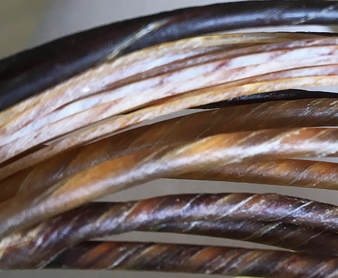The Strings
(For english see below)
|
La cuerdas de las vihuelas de arco estaban fabricadas exclusivamente de tripa de animal y constituyen un factor decisivo en la formación del sonido de una vihuela de arco.
Según todas las fuentes históricas conocidas, dichas cuerdas se fabricaban con tripa de animal ovino lavada, torsionada y dejada secar. «His autem chordis ex arietum intestinis communiter factis» (Johannes Tinctoris, De Inventione et usu Musicae, Nápoles, 1481-83). Existían al menos tres tipos diferentes de cuerdas elaboradas con Diferentes tipos de tripa (animal concreto, edad, procedencia, etc.): uno específico para los registros agudos, otro para los medios y otro para los graves (de carnero viejo en este caso), en función de sus propiedades de elasticidad y rigidez. Los instrumentos se encordaban con esmero y cuidado para un óptimo funcionamiento relativo en todos sus registros, denotando una especial atención a criterios como la homogeneidad, la armonía y la proporción. Las cuerdas de tripa son –en virtud de las propiedades del material con que estaban fabricadas– probablemente las que menos adulteran el sonido natural de la madera de la tapa armónica y la caja de resonancia de las vihuelas, cuyos espesores y características estructurales estaban originalmente diseñados para el funcionamiento con dichas cuerdas de tripa optimizando sus prestaciones. Este material orgánico (maderas, colas, tripas…) reacciona a la excitación vibratoria de una forma diferente que el artificial, produciéndose en ocasiones interesantes propiedades emergentes en su punto critico, donde logran su mayor rendimiento sonoro. Además estos materiales orgánicos están siempre cambiando, evolucionando, adaptándose a las condiciones del medio, lo que hace más estable su respuesta acústica. Esta respuesta acústica, además, es la mas adecuada a las necesidades de la esencia de la música de la época tanto en aspectos como el volumen sonoro –con unos registros graves y agudos equilibrados en función especifica relativa al todo de la masa sonora y no como una entidad propia independiente–, la armonía, la articulación, el color o el matiz del sonido. No hay instrumento musical más perfecto que la voz humana. Los antiguos la tenían como modelo a imitar, también con la vihuela. Las cuerdas vocales también son un material orgánico cartilaginoso con base en colágeno, como la tripa. La intervención de materiales modernos (plástico, metal entorchado, etc.) en la elaboración de las cuerdas supone una tentativa intencionada de adaptar, o supuestamente mejorar, la función de la sustancia Sonora a la psicología estética moderna. Esta estética es diferente de la concepción que tenían los antiguos, la cual incluía un componente alquímico y espiritual atribuido los materiales vivos. Una vihuela con cuerdas de plástico (o entorchado de metal) dejaría de ser un instrumento orgánicamente vivo que intenta imitar el canto de la voz humana. |
"La vihuela de arco faze dulçes vayladas, adurmiendo a las vezes, muy alta a las vegadas, vozes dulces, sabrosas, claras e bien puntadas, a las gentes alegra, a todas Ayene pagadas." Arcipreste de Hita (ca.1351)
|
